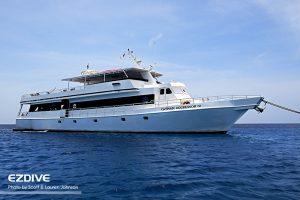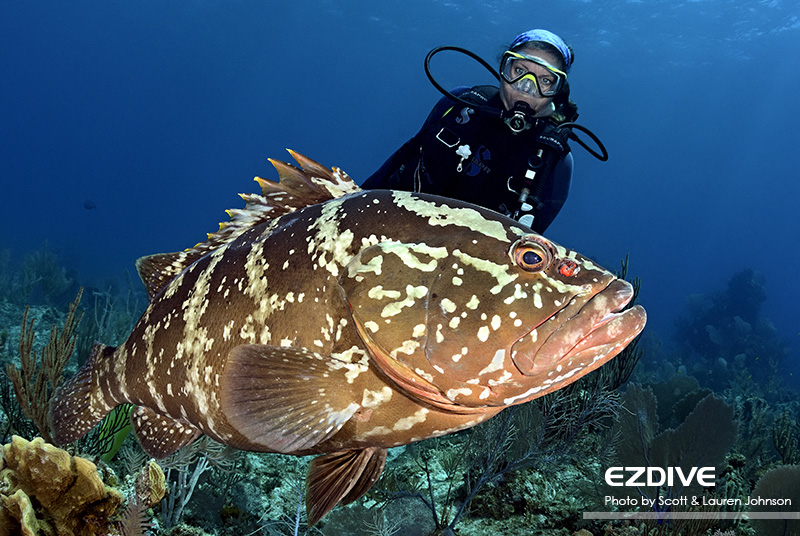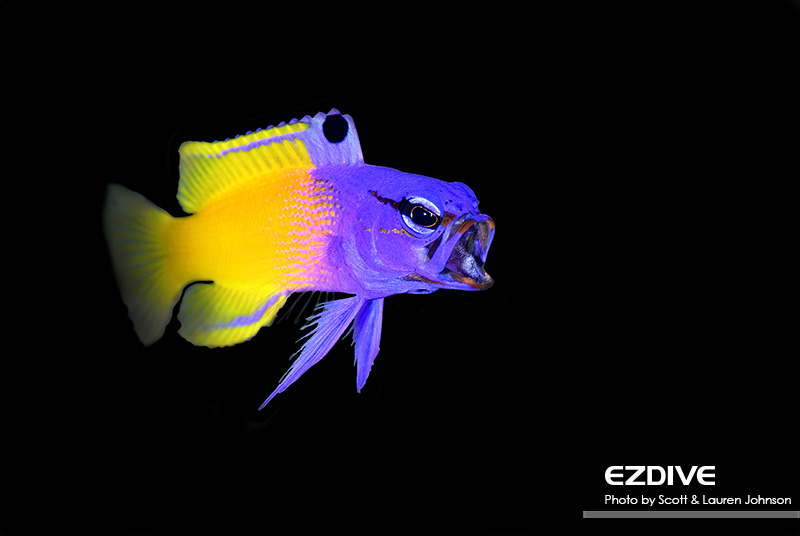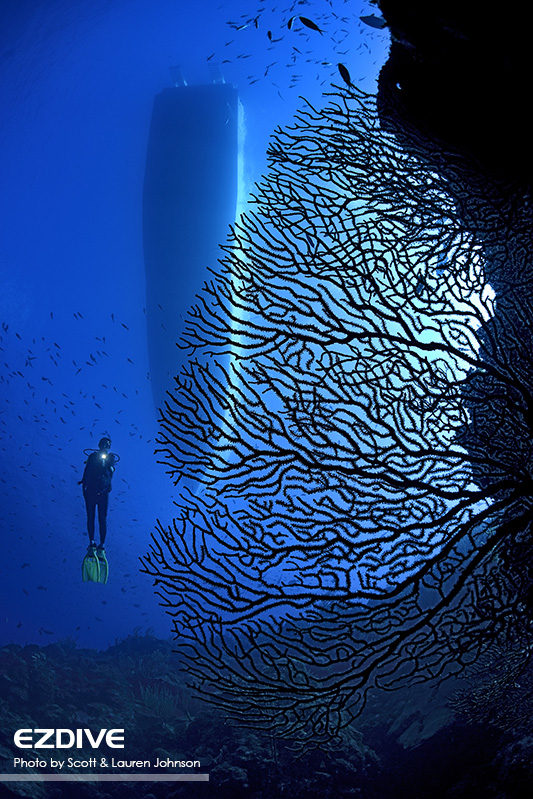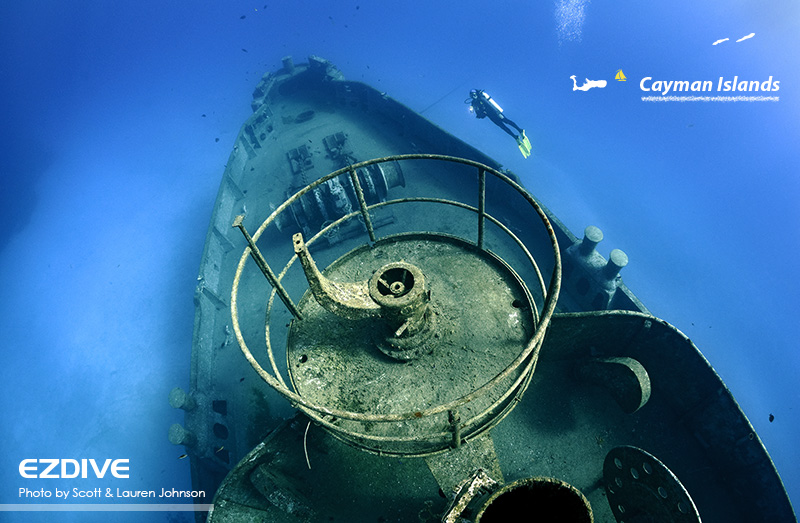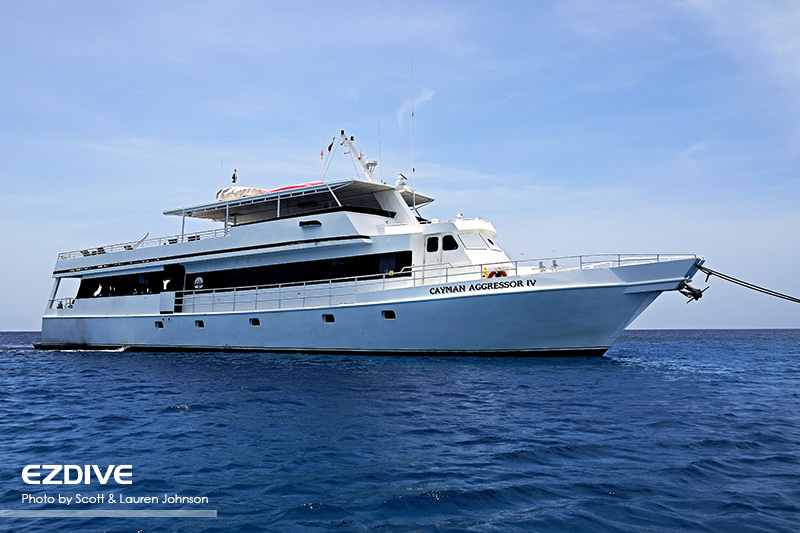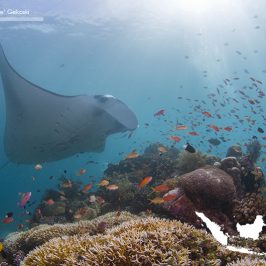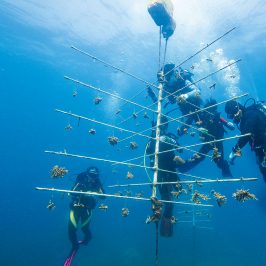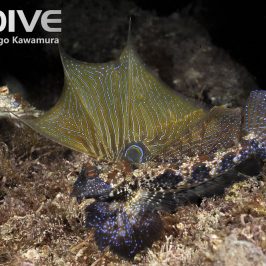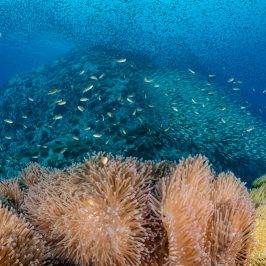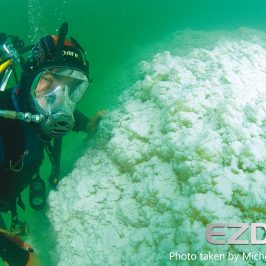Clear water… check. Dancing sunbeams… check. Neon colored sponges… check. Schooling blue tangs… check. Model in perfect position… check. Easy shot… uh, no. The scene through my viewfinder suddenly morphs from a dazzling panorama to two puppy-dog-like eyes. I raise my head to find a large Nassau grouper staring at me and wiggling its pectoral fins as if to say, “Let’s play!” Such is the diving in the Cayman Islands. The water is consistently clear. The reefs are consistently healthy. And the animal encounters are consistently engaging.
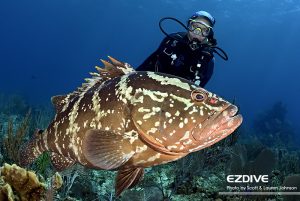
Text and Photography by Scott & Lauren Johnson
Crown Jewels of the Caribbean
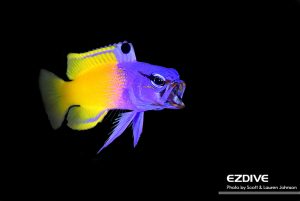 The Caymans represent a three-island archipelago comprised of Grand Cayman, Cayman Brac and Little Cayman in the western Caribbean Sea. This British Overseas Territory lies approximately 724 kilometers south of Miami, Florida, 274 kilometers northwest of Jamaica and 241 kilometers south of Cuba. Cayman Brac and Little Cayman, known as the Sister Caymans, are 143 kilometers northeast of Grand Cayman and only 8 kilometers apart.
The Caymans represent a three-island archipelago comprised of Grand Cayman, Cayman Brac and Little Cayman in the western Caribbean Sea. This British Overseas Territory lies approximately 724 kilometers south of Miami, Florida, 274 kilometers northwest of Jamaica and 241 kilometers south of Cuba. Cayman Brac and Little Cayman, known as the Sister Caymans, are 143 kilometers northeast of Grand Cayman and only 8 kilometers apart.
These three islands look predominately flat but they are actually the pinnacles of a submarine mountain range called the Cayman Ridge (Cayman Rise). The Cayman Ridge forms the northern margin of the Cayman Trough (Cayman Trench), which plunges to 7,686 meters; the deepest point in the Caribbean Sea. The islands’ crowning positions atop the steep ridge, their porous limestone foundations and the trough’s penetrating depth are part of a complex marine ecosystem that features unique underwater formations and breathtaking drop-offs.
Bloody Bay Marine Park
Little Cayman is aptly named. Any island 14.5 kilometers long, 1.6 kilometers wide, with a maximum elevation of 12 meters and hosting a population of fewer than 200 people qualifies as little. This runt of the litter may not seem all that impressive above the water, but once you slip beneath the waves, you will find a world that is definitely not short on thrills.
Though the island is ringed with places to dive, the most renowne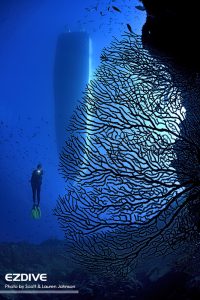 d sites are along the northern coast in the Bloody Bay Marine Park. The park is divided into two distinct wall systems: Bloody Bay Wall to the west and Jackson Bight (Jackson Wall or simply Jackson) to the east. Bloody Bay Wall features vertical walls that appear to continue to infinity, while Jackson Bight is more like a coral playground with rolling slopes, mini walls, coral head mazes and large sand patches.
d sites are along the northern coast in the Bloody Bay Marine Park. The park is divided into two distinct wall systems: Bloody Bay Wall to the west and Jackson Bight (Jackson Wall or simply Jackson) to the east. Bloody Bay Wall features vertical walls that appear to continue to infinity, while Jackson Bight is more like a coral playground with rolling slopes, mini walls, coral head mazes and large sand patches.
On the first morning of our 10 day charter aboard the Cayman Aggressor IV (CAIV), Niall Lawlor, the quick-witted and thoroughly entertaining captain of the boat, proclaims in a charming Irish brogue, “Here we are at Leah Leah’s Lookout on Bloody Bay Wall in world famous Bloody Bay Marine Park. The wall is decorated with brilliant fans and sponges. We have a swim through at 14 meters that leads to a mesmerizing view of the drop-off around 27 meters. The animals, especially the grouper, turtles and giant morays, are very approachable, if not downright nosy, here in Little Cayman.”
Lawlor did not exaggerate in describing the wall, which is festooned with great barrel sponges, yellow tube sponges and pink vase sponges. The colors are truly radiant. And the aforementioned grouper with the puppy-dog-like eyes jockeyed with one of its mates to be first in line should we be on a licensed lionfish hunt.
Randy’s Gazebo offers one the most picturesque scenics in the Caribbean. The gazebo is a sponge-encrusted, limestone swim-through positioned in front of the main drop-off at 24 meters. I carefully entered the gazebo trying not to disturb the sand or sediment and then framed Lauren holding her flashlight against the tranquil blue of open ocean.
3 Fathom Wall is where Bloody Bay Wall and Jackson Bight converge and the site of our next two dives. The top of the wall is a good place to spend an extended safety stop as it starts at only 5 meters or three fathoms. We head west on our first dive to shoot wide angle along the sheer wall. When I turn my back to the reef, spread my arms open wide and stare into the depths, I feel like I am skydiving through an undersea sky. On our second dive, we go east in search of small critters living in the crevices of the craggy, slopping wall and in patches of sand and rubble.
Jackson Bight’s Bus Stop was named for the remains of a school bus that used to sit on the nearby shore. The bus has long since rusted away, but the site rolls on. The CAIV is moored over a large sand chute that leads from the shallows to the lip of a blue water drop-off around 30 meters. I spend most of two dives lying in the sand at 12 meters attempting to photograph the sailfin blennies and yellowhead jawfish that are so prevalent here.
Russian Delight
Cayman Brac, the most topographically diverse island in the archipelago, is named after the central, limestone bluff (‘brac’ is Gaelic for ‘bluff’) that runs the length of the island and dramatically peaks in a 43 meter cliff that plunges to the sea on its eastern end. The Brac, as locals call it, was the hideout for some of the most notorious pirates in the Caribbean, such as Edward Teach, aka Blackbeard, due to its high ground and numerous caves.
While the Brac has its own share of sponge-ornamented walls and photogenic coral formations, the signature dive is clearly the wreck of the M/V Captain Keith Tibbetts. This 101-meter Russian frigate was intentionally sunk on September 17, 1996 off the tapered, northwestern point of the island. Galvanic corrosion quickly began to take a toll on the wreck wherever the steel hull met the aluminum superstructure. Then, the bow and forward half of the ship were pushed sharply to port by a storm in January 1999. The midships is now a debris field, while the stern is still upright in the sand at 18 meters. The bow rests canting to port at 27 meters and points toward Garden Eel Wall, and a swim-through leading to the open ocean, less than 30 meters away.
Grand Diving
Not to be outclassed by the Sister Islands to the east, Grand Cayman hosts its own famous wreck, the USS Kittiwake 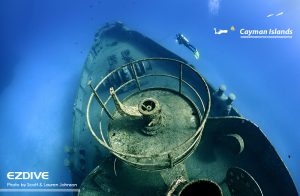 (ASR-13), boasts the ‘Best Twelve Foot Dive on the Planet’ in Stingray City and offers a wide variety of exciting sites. The Kittiwake is a former United States Navy Chanticleer-class submarine rescue vessel that now serves as popular artificial wreck. Intentionally sunk in 2011, the intact wreck can be explored at depths from 4.6 meters to 19.5 meters. Almost 6 years of submerged rest have transformed the Kittiwake into a thriving marine community. Creole wrasse, great barracuda, horse-eye jacks and midnight parrotfish are among the residents.
(ASR-13), boasts the ‘Best Twelve Foot Dive on the Planet’ in Stingray City and offers a wide variety of exciting sites. The Kittiwake is a former United States Navy Chanticleer-class submarine rescue vessel that now serves as popular artificial wreck. Intentionally sunk in 2011, the intact wreck can be explored at depths from 4.6 meters to 19.5 meters. Almost 6 years of submerged rest have transformed the Kittiwake into a thriving marine community. Creole wrasse, great barracuda, horse-eye jacks and midnight parrotfish are among the residents.
Stingray City is located southeast of Barker’s Cay in the mouth of the North Sound. However, it is more the name of an incredible experience than a physical place. Divers kneel in the sand at a maximum depth of 3.7 meters to form a large circle. A guide then gives each person a piece of squid to use as a treat for one of the swarming southern stingrays. These large rays are usually shy when encountered at other destinations, but, at Stingray City, they are wild and willing participants in a wonderful aquatic petting zoo.
Looking back at the 40 dives during our charter, each site has obviously been consistently protected for decades. The mooring buoys have prevented unnecessary anchor-related damage. The fishing management guidelines have enabled fish to reach sexually maturity, spawn and consistently replenish the reefs. And, dive operations, like the CAIV, have partnered with the government and one another to consistently protect and nurture the marine ecosystem. The end results are healthy, luminous reefs that host a wide variety of curious and photogenic creatures. Cayman diving is consistently spectacular.
Getting There
A variety of air carriers fly to Grand Cayman, the port for the Cayman Aggressor IV, from North America and Europe. The Sister Caymans can be reached via Cayman Airways and boats from Grand Cayman.
Departure Tax/Visa Requirements – Visa-free countries and regions include Hong Kong, Taiwan, Malaysia, and Singapore etc. Citizens of Mainland China and Thailand shall need a UK visa. A list of visa and non-visa requirements by nationality can be accessed at www.immigration.gov.ky
A departure tax is included in the cost of international airfare
Language
English is the official language.
Currency
Cayman Islands Dollar, U.S. Dollars, British Pounds and credit cards are widely accepted.
Electricity
110 volts/60Hz, plugs are U.S. standard.
Operator
Cayman Aggressor IV – www.aggressor.com
